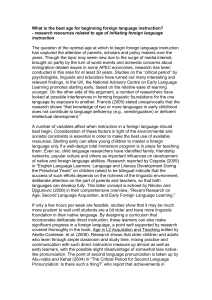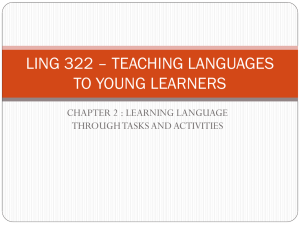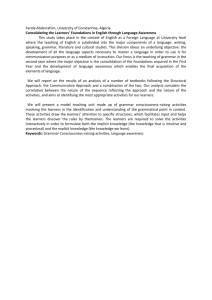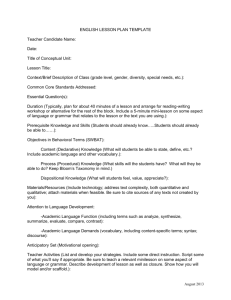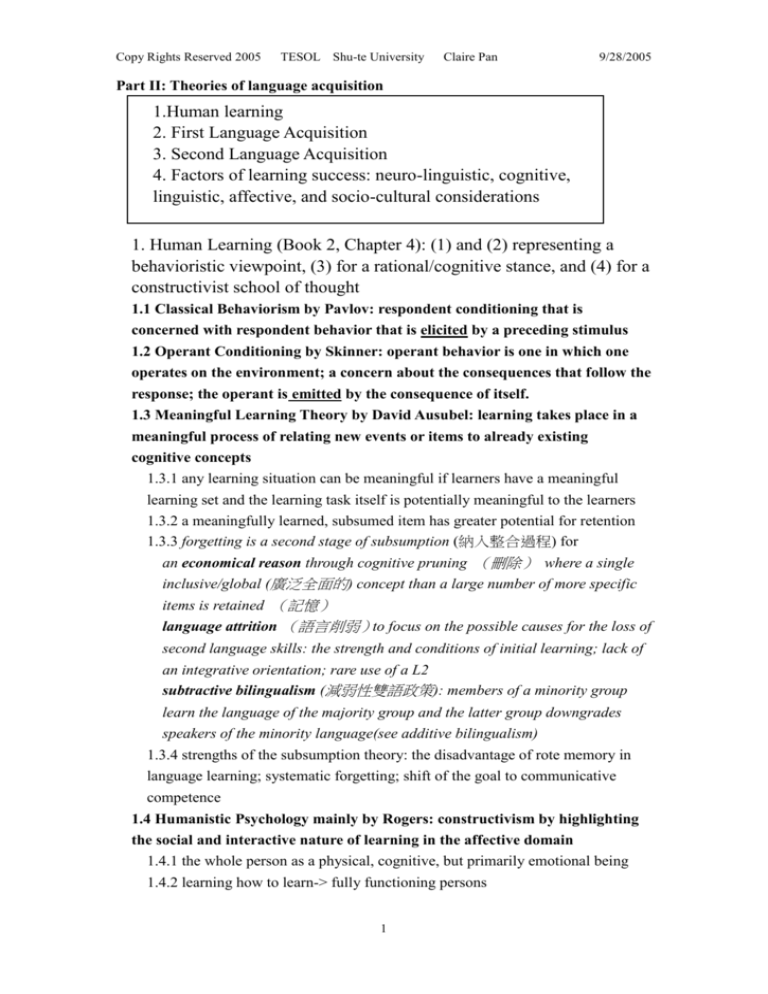
Copy Rights Reserved 2005
TESOL Shu-te University
Claire Pan
9/28/2005
Part II: Theories of language acquisition
1.Human learning
2. First Language Acquisition
3. Second Language Acquisition
4. Factors of learning success: neuro-linguistic, cognitive,
linguistic, affective, and socio-cultural considerations
1. Human Learning (Book 2, Chapter 4): (1) and (2) representing a
behavioristic viewpoint, (3) for a rational/cognitive stance, and (4) for a
constructivist school of thought
1.1 Classical Behaviorism by Pavlov: respondent conditioning that is
concerned with respondent behavior that is elicited by a preceding stimulus
1.2 Operant Conditioning by Skinner: operant behavior is one in which one
operates on the environment; a concern about the consequences that follow the
response; the operant is emitted by the consequence of itself.
1.3 Meaningful Learning Theory by David Ausubel: learning takes place in a
meaningful process of relating new events or items to already existing
cognitive concepts
1.3.1 any learning situation can be meaningful if learners have a meaningful
learning set and the learning task itself is potentially meaningful to the learners
1.3.2 a meaningfully learned, subsumed item has greater potential for retention
1.3.3 forgetting is a second stage of subsumption (納入整合過程) for
an economical reason through cognitive pruning (刪除) where a single
inclusive/global (廣泛全面的) concept than a large number of more specific
items is retained (記憶)
language attrition (語言削弱)to focus on the possible causes for the loss of
second language skills: the strength and conditions of initial learning; lack of
an integrative orientation; rare use of a L2
subtractive bilingualism (減弱性雙語政策): members of a minority group
learn the language of the majority group and the latter group downgrades
speakers of the minority language(see additive bilingualism)
1.3.4 strengths of the subsumption theory: the disadvantage of rote memory in
language learning; systematic forgetting; shift of the goal to communicative
competence
1.4 Humanistic Psychology mainly by Rogers: constructivism by highlighting
the social and interactive nature of learning in the affective domain
1.4.1 the whole person as a physical, cognitive, but primarily emotional being
1.4.2 learning how to learn-> fully functioning persons
1
Copy Rights Reserved 2005
TESOL Shu-te University
Claire Pan
9/28/2005
1.4.3 teachers as facilitators of learning through the establishment of
interpersonal relationships with learners and genuine trust and empathy
1.4.4 establishment of a climate of nondefensive learning
1.4.5 empowerment of students (students are allowed to negotiate learning
outcomes, to cooperate with teachers and other learners, to engage in
critical thinking, and to relate everything they do in the school to their reality
outside the classroom), not banking (filling students by making deposits of
information) (by Paolo Freire)
Behavioristic
classical: (Pavlov)
respondent conditioning
elicited response
S->R
operant: (Skinner)
Cognitive
Constructivist
(Ausubel)
(Rogers)
meaningful=powerful fully functioning
person (全功能
rote=weak
subsumption (歸入)的人)
of new items under a learn how to learn
governed by consequences
(由結果主宰)
emitted response (發出回應)
more inclusive
community of
learners (學習者
conceptual system
association (聯結) 的共同生活)
empowerment(權
R-> S (reward)
and retention
No punishment
systematic forgetting 力的賦予)
Programmed instruction (編序 (系統性的遺忘)
教學)
cognitive pruning
(認知性的刪除)
2. L1 Acquisition
2.1 Introduction to Language Acquisition
Interests in L1 competence for many centuries
(1) beginning of analyzing child language systematically and its psychological
process in the second half of the 20th century
(2) analogies between L1 and L2 acquisition especially the differences in the
case of adult SL learning in terms of cognitive and affective contrasts
(3)three theoretical positions of first language acquisition
2.2 Theories of L1 acquisition
2.2.1 Behaviorism (Say What I Say): a psychological theory of learning claiming
lg learning is the result of imitation, practice, consistent feedback (reinforcement)
on success and habit formation (in the 1940s-50s in the U.S.)
(a) assumptions: “Behavirism” deriving from Pavlov and Watson first and
extended by Skinner.
Children come into the world with a tabula rasa, a clean slate bearing no
2
Copy Rights Reserved 2005
TESOL Shu-te University
Claire Pan
9/28/2005
preconceived notions about the world or about language as to be shaped by
their environment and slowing conditioned through reinforcement
Effective language behavior is the production of correct responses to
stimuli. If a particular response is reinforced, it then becomes habitual or
conditioned.
(b) Verbal Behavior by B.F. Skinner (1957): an experimental behavioristic
model of linguistic behavior extended from operant conditioning as the
dominant paradigm of psychology in the U.S. from the 1920s to 1970s.
*Assumption: more emphasis on the consequences of a stimulus than on
the stimulus itself
(i) an operant (an utterance) is emitted, nor elicited, without necessarily
observable stimuli;
(ii) that operant is learned by reinforcement such as from another person.
(iii)verbal behavior is controlled by its consequences((rewards and no
punishment ) which increase the probability of a recurrence of that behavior
*Criticism: Behaviorism cannot explain creativity of child language (by Noam
Chomsky, transformational generative grammar, e.g. use of the past -tense
verbs); it tends to decrease internal motivation although there are situations
when incentives and external supports are necessary; it can’t explain how
children acquire complex grammatical structures
* Strength: it offers a reasonable way of understanding how children learn
some of the regular ad routine aspects of lg
* tactics for teachers in the use of behavioral management: (1) direct teaching
is useful to maintain class discipline and to teach such topics as precise
mastery of grammar, vocabulary, or pronunciation. (2) Behavioral
management in the classroom is useful when rewards are in demand and the
students depend on the teacher for the rewards. (3) Balancing external rewards
with intrinsic motivation meets the needs of a variety of students. (4) Careful
alignment of instructional objectives, direct teaching, and assessment is useful
for mastering a highly structured curriculum. (5) Mastery learning
supplements direct instruction by inducing students to achieve incremental,
precisely defined objectives.
(c) Mediation theory ( extended from behaviorism)by Charles Osood (1957):
The linguistic stimulus (a word or sentence) elicits a mediating response that
is self-stimulating, a representational mediation process (表象媒介過程)
* criticism: unable to resolve the abstract nature of language since the deep
structures in sentences in a person’s cognitive and affective experience were
scarcely plumbed.
(d) Another extension from behaviorism by Jenkinds and Palermo (1964): A
3
Copy Rights Reserved 2005
TESOL Shu-te University
Claire Pan
9/28/2005
child may acquire frames of a linear pattern of sentence elements and learn
the stimulus-response equivalences that can be substituted within each frame;
imitation was important to establish stimulus-response associations.
2.2.2 The Nativist Approaches (語法天生說)It’s all in your mind
(a) innateness hypotheses (Innatism)
(i)Assertion: language acquisition is innately determined.
* Language is a species-specific behavior and certain modes of
perception, categorizing abilities are biologically determined so
virtually every child learns lg on a schedule which is similar in
spite of different circumstances of life (by Eric Lenneberg, 1967,
a biological view to compare learning to talk with learning to
walk at the right time)
* Language acquisition device (LAD) in a little black box (暗箱)
where children are exposed to confusing input and given no
corrective feedback; it contains all and only the principles which
are universal to all human lgs; input triggers its operation.
* “What LAD does by Anderson: sound discrimination,
organization of linguistic data, only one possibility of a certain
kind of linguistic system within one’s head, constant evaluation in
developing linguistic system to construct the simplest possible
system out of the available linguistic input (by Chomsky, 1965)
(ii) strengths: able to account for the generativity of child language, lg abilities
as human specific ones different from other aspects of cognitive development,
success of learning L1 for children by mastering the basic structure of L1 in a
variety of conditions with insufficient input and limited correction.
(b) Universal Grammar (Cook 1993, Mitchell & Myles 1998)共通語法 as
children’s innate endowment rather than LAD any longer by Chomskians
(i) all human beings are genetically equipped with a set of principles which are
common to all lgs that enable them to acquire language
(ii) to discover what it is that all children bring to the language acquisition
process from question formation, negation, word order, subject deletion and so
on.
(iii) If children are pre-equipped with UG, then what they have to learn is the
ways in which their own lg makes use of these principles and the variations
(parameters) on those principles which may exist in the particular lg which
they hear spoken around them.
(c) the development of generative grammar: children construct hypothetical
4
Copy Rights Reserved 2005
TESOL Shu-te University
Claire Pan
9/28/2005
grammar, formal representations of deep structures which start as pivot
grammars (two-word utterances for two word classes) and mature
(d) the Parallel Distributed Processing (PDP) Model 平行分散處理
(Connectionism 連結論 by Feldman) : See Summary of SLA below
(i) A learner’s linguistic performance may be the consequence of many levels
of simultaneous neural interconnections rather than a serial (連續性)process
of one rule being applied, then another and so on; lg acquisition does not
require a separate module of the mind but can be explained in terms of
learning in general (refutation to the innatism); what children need to know is
essentially available in the lg they are exposed to such as a computer program
which can learn certain things if it is exposed to them often enough.
(ii) refutation of the generative rule-governed model: generative rules (衍生
語法) in a linguistic sense are not connected serially, with one connection
between each pair of neurons in the brain
(iii) connectionism describes mental processing by means of connections
among very simple processing units in complex neural networks; learning
consists of adjusting the strengths of connections by frequent patterns in the
input so that a given teaching input finally results in a desired output; no
innate endowment or mechanism specifically pre-programmed for lg learning;
so there are no “rules” in connectionist systems although they exhibit regular
or rule-like behavior.
(e) Contributions of Nativism:
(i) able to explore the unseen, observable, underlying, abstract linguistic
structures being developed in the child
(ii) systematic description of the child’s linguistic repertoire as either
rule-governed or operating out of parallel distributed processing capacities
(iii) the construction of a number of potential properties of UG
2.2.3 the interactionism (a little help from my friends)
(a) Two emphases:
(i) seeing language as one manifestation of the cognitive and affective ability
to deal with the world, with others and with the self; lg develops as a result of
the complex interplay between the uniquely human characteristics of the child
and the environment in which the child develops.
(ii) nativism as being unable to deal with the deeper levels of meaning of
language constructed from social interaction but with the forms of language
(iii) lg which is modified to suit the capability of the learner is crucial element
in the lg acquisition process e.g. child-directed speech- the lg addressed to
children and adjusted in ways that make it easier for them to understand
5
Copy Rights Reserved 2005
TESOL Shu-te University
Claire Pan
9/28/2005
(iv) lg acquisition is similar to and influenced by the acquisition of other kinds
of skill and knowedge, rather than as sth independent of the child’s experience
and cognitive development.
(b) cognition and language development:
(i) Lois Bloom (1971): children learn underlying structures and not superficial
word order as shown in pivot grammar, depending on the social context
(ii) Jean Piaget (1969): what children know (cognition development) will
determine what they learn about the code for both speaking and understanding
messages (language development)
sensorimotor stage (Age 0-2) 感官動作期
preoperational stage (2-7)前運思期
operational stage (7-16)- concrete operational stage (7-11) 具體運思期;
formal operational stage (11-16 formal thinking at puberty) 形式運思期
(iii) Dan Slobin (1971): in all languages, semantic learning depends on
cognitive development and that sequences of development are determined
more by semantic complexity, than by structural complexity-> schema of
cognition on the functional level and schema of grammar on the formal level
(c) social interaction and language development
(i) Holzman (1984): a reciprocal model
-> a reciprocal system operates between the language –developing infant-child
and the competence adult language user in a socializing-teaching-nurturing
role
(ii) Berko Gleason (1988) & Lock (1991): the interaction between language
acquisition and learning of social systems
(iii)Budwig (1995) & Kuczaj (1984): the function of language in discourse
(relations between sentences) in terms of conversational cues
Overview 1: The Dynamics of Methodological Change
1. 1840s to 1860s:
The Grammar-Translation Method (GTM; also the Classical Method):
Inspired by Latin and Greek learning in grammar schools for centuries in
Europe; aiming at appreciation of foreign literature and mental exercise
(Mental Discipline Theory) by deductive teaching of grammatical rules,
memorization of lists of isolated words, translations of texts and doing
written exercises.
It is criticized of being a tedious experience of memorizing endless lists of
unusable grammar rules and vocabulary and attempting to produce perfect
translations of literary prose. It is fully “theory-lessness”. However, it
requires few specialized skill on the par of teachers. Tests of grammar rules
6
Copy Rights Reserved 2005
TESOL Shu-te University
Claire Pan
9/28/2005
and of translations are easy to construct and can be objectively scored. It is
at times successful in leading a student toward a reading knowledge of a L2.
The Direct Method (popular in the early 20th century): Deriving from
Gouin’s Series Method and then developed by Berlitz, who called it the
Berlitz Method
Refutation to GT, which ignored language use, and application of IPA (1886)
to assist teaching of pronunciation; L2 learning similar to L1 learning where
lots of oral interaction, spontaneous use of the lg, no translation, and little or
no analysis of grammatical rules are found.
Ss are highly motivated and native-speaking teachers are employed. But it
was only favored in private schools which could afford small classes and
high budget. It is also criticized for its weak theoretical foundations. Its
success may have been a factor of the skill and personality of the teacher
rather than the method itself.
2. 1930s-60s:
The Audio-lingual Method: (after the Reading Approach)
Based on Behavioral Psychology, Structuralism and the Contrastive
Analysis (the morpheme studies), this method aims at using the target
language communicatively by intensive oral drilling of basic sentence
patterns but it was challenged by Noam Chomsky in the early 60s.
At the same time, the Situational Approach prevailed in the U.K.
It is criticized for its failure to teach long-term communicative proficiency,
misconceptions of learning as a process of habit-formation and overlearning,
avoidance of errors, and inadequate theoretical foundations of structural
linguistics which did not tell us everything about lg that we needed to know.
3. 1970s (the Designer Methods: promises of success, one size fits all by David
Nunan, 1989 ):
Influenced by the theories of second language learning such as the
Error Analysis, Krashen’s theories, Shumann’s
pidginization/acculturaltion Model; the 1970s is significant, for since
then research on SLA became a single discipline in its own right, and a
number of innovative methods were conceived.
The Cognitive Approach: (p.6)
The emphasis on human cognition led to see learners in a more active role
to formulate hypotheses to discover the rules of the target language. When
errors occur, they are signs that learners are testing their hypotheses.
7
Copy Rights Reserved 2005
TESOL Shu-te University
Claire Pan
9/28/2005
Deductive and inductive grammar exercises were developed.
The Silent Way (by Caleb Gattegno): a problem-solving approach to learning
Discovery learning is facilitated by accompanying physical objects
(Cuisenaire rods, wall charts) and problem-solving. In this way, learners
develop independence, autonomy, and responsibility.
Ss benefit from healthy doses of discovery learning and less teacher talk.
However, it was too harsh a method and the teacher too distant. The rods
and charts wear thin after a few lessons and other materials then must be
introduced instead.
Desuggestopedia (by Georgi Lozanov): superlearning (relaxed concentration)
It assumes that the human brain could process great quantities of material if
given the right conditions for learning, among which are a state of
relaxation and giving over of control to the teacher. So it capitalizes on
relaxed states of mind for maximum retention of material where Ss are
encouraged to be as childlike as possible. Influenced by humanistic
psychology, this method respect learners’ feelings and desuggest their
limitations on learning via integration of the fine arts (music, paintings, and
drama) and peripheral learning.
It is criticized for the highly questionable experimental data of Lozanov and
a lack of practicality as well as the issue of the place of memorization,
excluding references to understanding or problem-solving. However,
deliberately induced states of relaxation may be beneficial in the classroom
and music has proved to help relax people.
Community Language Learning (by Charles Curran, 1972):
A counseling-learning model in which non-defensive learning is achieved
with six elements (security, aggression, attention, reflection, retention, and
discrimination) and learners are considered “whole persons.” It aims at
building a supportive community of Ss to interact in an interpersonal
relationship, to lower defenses, and to meet learner needs.
The principles of discovery learning, student-centered participation and
development of student autonomy (independence) remain viable in the
application to lg classrooms. But it was too restrictive for institutional lg
programs. Teachers are too non-directive, and their translation expertise
determines success. Finally, there is too much reliance on an inductive
strategy of learning.
Total Physical Response (by James Asher, 1977):
8
Copy Rights Reserved 2005
TESOL Shu-te University
Claire Pan
9/28/2005
Based on the Comprehension Approach (p.6), understanding precedes
production. Meaning is conveyed through actions (instructions given by the
teacher); memory is increased if it is stimulated or traced through association
with motor activity which is a right-brain function (the trace theory of
learning). Learners’ learning anxiety has to be lowered.
It seems to be especially effective in the beginning level and its appeal to the
dramatic nature of lg learning is attractive. It can also be used into more
advanced proficiency levels by incorporating more complex syntax into the
imperative. However, in TPR reading and writing activities, Ss are limited to
spinning off from the oral work in the classroom.
The Natural Approach (by Tracy Terrel and Stephan Krashen, 1982):
Acting on the claims of the Comprehension-based Approach, NA maintains
that production delayed until speech emerges and basic personal communication
skills taught in a relaxed atmosphere where the teacher provides comprehensible
input. Fluency is pursued instead of accuracy.
The most controversial aspects of NA are its advocacy of a silent period and
emphasis on comprehensible input since speech does not always emerge
naturally and the decision of which structure to be included is somehow intuitive.
However, NA’s advice of a silent period is good while Ss grow accustomed to a
new lg since their lg ego is not easily threatened and no immediate risk-taking is
forced.
4. 1980s: significance of communicative competence by Dell Hymes; functional
approaches
The Communicative Language Teaching: (learn to use English) the
notional-functional syllabus as a precursor to CLT
1. goal: communicative competence by using activities of information gap,
choice and feedback (Johnson and Morrow, 1981)
2. authentic language and materials
3. integration of forms, meanings and functions
4. the principles of task, meaningfulness and
The Content-based approach: (use English to learn it)
1. the integration of content learning which is relevant to and interesting to
Ss with lg teaching aims
2. Its effective form, competency-based instruction, develops learners’
language skills at the same time they learn survival or life-coping skills.
3. an increase in intrinsic motivation and empowerment
9
Copy Rights Reserved 2005
TESOL Shu-te University
Claire Pan
9/28/2005
The Whole Language Approach: to describe cooperative learning, participatory
learning, learner-centered learning, focus on the community of learners and the
social nature of lg, use of authentic, natural lg, meaning-centered lg, holistic
assessment techniques in testing and integration of the four skills
1. Language is regarded holistically, rather than pieces.
2. Learners work from the top-down to understand the meaning of whole
texts before they work on the linguistic forms- purposeful use of
language
3. the interaction and interconnection between oral lg and written lg
4. the importance of the written code as natural and developmental as the
oral code is.
The Task-based approach: (use English to learn it)
1. learning as a set of communicative tasks (techniques or activities) that
are directly linked to the curricular goals they serve, the purposes of
2.
3.
4.
5.
6.
which extend beyond the practice of lg for its own sake
meaning is primary
there is some communication problem to solve
comparable real-world activities
task completion has some priority
the assessment of the task is in terms of outcome
The Participatory approach: (use English to learn it)
1. help learners to understand the social, historical, or cultural forces that
affects their lives and thus take action and make decisions to gain
control over their lives
2. The nature of the content is based on issues of concern to learners
(experiencec-centered)(difference to the Content-based approach)
Learning strategy training:
1. good language learners by Rubin 1975
2. Build on learners’ prior knowledge and learning experiences
3. To teach learning facilitates learners’ academic success
4. Learning strategies by Chamot and O’Malley (1994)
(a) metacognitive strategies
(b) cognitive strategies
(c) social-affective strategies
10
Copy Rights Reserved 2005
TESOL Shu-te University
Claire Pan
9/28/2005
Cooperative Learning: (related to Grice’s Conversation Maxims)
1.
2.
3.
4.
Positive interdependence among students in groups in a cooperative way
Social skills to be taught
Responsibility and accountability for each other; distributed leadership
more structured and more directive to Ss about how to work together in
groups than collaborative learning where Ss engage with more capable
others who provide assistance and guidance.
Interactive learning:
1. Most meaning is a product of negotiation-> group/pair work
2. authentic classroom tasks in real-world contexts by practicing oral
communication
3. based on the Interaction Hypothesis by Michael Long: the importance of
input and output in the development of lg where Ss interact with each
other through oral and written discourse to enhance their communicative
abilities.
Learner-Centered Instruction: one concern within a CLT framework
1. focus on learners’ needs, styles, and goals
2. empowerment of Ss
3. no presupposition of curricular objectives in advance
4. creative and innovative techniques
5. enhancement of Ss’ sense of competence and self-worth.
Multiple Intelligences: by Howard Gardner (1983)
1. two kinds of learners by Hatch, 1974
(a) data-gatherers
(b) rule-formers
2. multiple intelligences: Learners bring with them specific and unique
strengths
(a) logical/mathematical
(b) visual/spatial
(c) body/kinesthetic
(d)
(e)
(f)
(g)
(h)
musical/rhythmic
interpersonal
intrapersonal
verbal/linguistic
naturalistic
11


